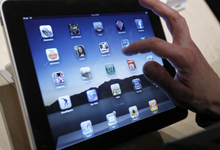Journalists have long defined themselves by the medium that carries their work. They say they write for magazines, newspapers or the Web. No one says, “I write for tablets.”
Yet as more tablet-focused startups and spinoffs are developed, more journalists are seeing their bylines as tappable things connected to experiences, instead of articles. And this often changes how — and with whom — they work.
These days, many publishers are thinking “mobile-first” — even though they disagree on what that means. As always, where publishers go, writers follow — and the tablet is where journalists really want to go now, because that’s where the long-form print story has been reborn, and is being transformed through digital experiments.
More words, different experience
Each month dozens of pitches, mostly from magazine writers, pour into The Atavist, a Brooklyn, N.Y.-based digital publishing company that produces one original, long-form nonfiction story between 5,000 and 30,000 words monthly.
“We’re going to treat the piece the way it would get treated somewhere like The New Yorker,” said Evan Ratliff, co-founder, CEO and editor. “We’re going to make everything perfect, and then we promise them a very high production value on it.”
Now nearly three years old, The Atavist is notable for the seamless way it integrates audio, maps, video, photography, and even animation into its text narratives. But the story comes first: In a phone interview, Ratliff said multimedia elements aren’t added unless a good argument can be made for why they enhance the storytelling, and the reader can turn them off with a tap.
The Atavist’s artful inclusion of multimedia elements appeals to authors who believe their stories would benefit from that treatment. Take “Finding Shakespeare,” August’s story about a Vietnam veteran’s quest to discover how Shakespeare’s English actually sounded and to reproduce it on a New York stage. In reporting the story, Daniel Fromson said he gathered some six dozen film clips from the subject’s own documentary, as well as several boxes of letters, photographs, journals, screenplay drafts and other potential multimedia material “that ranged from receipts for his handyman business to readings of his horoscope.”
“I really do believe the multimedia in the story enhanced the story,” said Fromson, who has also written for The Atlantic and Harper’s, in a phone interview. “It would have been a good story without it, but the multimedia convey the general air of commitment bordering on obsession and the eccentricity of my subject.”
Fromson wanted to be involved with such efforts, but Ratliff said no commitment beyond production of a story’s audiobook is required of writers. An in-house production staff coordinates everything else.
Ratliff said it’s “pretty rare that we send a reporter out to actually gather multiple types of media. They come from somewhere else.”
Research into how people use tablets is helping shape the work produced on them. Long-form content, for instance, does well because readers read for longer periods of time on tablets than on other devices. They also read in the evenings — and do a great deal of tapping as they read.
“A high expectation comes with the device,” Poynter’s Sara Quinn said in March at a South by Southwest session on how people consume news on tablets. “During our study, we saw readers tap and tap on elements that weren’t tappable.”
Warning: distractions ahead
As with print magazines, tablet publications share certain physical characteristics but don’t resemble one another that much in terms of content. Not everyone thinks more multimedia is better for tablet readers of long-form journalism. Consider the debate after The New York Times published “Snow Fall: The Avalanche at Tunnel Creek” to near-deafening applause. The team that created “Snow Fall” had tablet consumers in mind as they integrated video, photography and motion graphics into one seamless story, and the piece won the 2013 Pulitzer Prize for feature writing. Soon, however, dissenting opinions emerged alongside a legion of imitators.
Bobbie Johnson, the co-founder of Matter, which publishes long-form stories on science, technology, medicine and the environment “for consumption on any device,” wrote a post called “Snowfallen” with the subtitle, “Just because you can, it doesn’t mean you should.”
“Snow Fall was a good story, but it felt as if getting you to read it was the story’s secondary ambition,” Johnson wrote. “When I did it, I was constantly interrupted or distracted. And while the multimedia elements provided atmosphere, in all honesty they didn’t mean much. As a reader they drew me away from what I was there for. I came away from it thinking ‘ooh, lovely design’ — not ‘this story is amazing.’ ”
Matter’s co-founder, Jim Giles, said their publication’s focus remains on the quality of the written stories. He said writers for Matter, which was acquired this spring by San Francisco-based Medium, haven’t told him they’ve changed anything about their process.
“So often I feel multimedia gets in the way,” he said in a telephone interview. “We’re selling an experience of being engulfed by a story — a story that’s meaningful, gripping, and you’re learning something about the world in the process.”
Mixing media
Elsewhere, though, examples of immersive multimedia stories featuring long-form writing are multiplying, and editors value the fusion of thoughtful, in-depth writing and interactivity. With the new capabilities of tablet publishing come new (or at least revised) expectations for writers.
At Quartz, a global business news outlet owned by Atlantic Media and based in New York City, reporters must think about multimedia and other visual elements, such as charts, said editor-in-chief and co-founder Kevin J. Delaney. For instance, when Apple recently released a chart showing cumulative iPhone sales, reporter David Yanofsky superimposed his own chart of quarterly iPhone sales. Although Apple’s chart makes it appear as if the iPhone universe is ever expanding, the quarterly information shows that sales are cyclical and have actually declined in recent quarters.
“[Yanofsky] has deep journalistic training,” Delaney said in a phone interview. “He understands how business works. He knows how to read regulatory filings by companies.”
Quartz reporters use a custom-designed chart-building tool to make such charts, which Delaney said are very popular with readers. (Quartz has open-sourced that software, and other news organizations are now using it.) Reporters also choose, crop and place the photographs accompanying their stories in the publishing system.
More collaboration required
At The Atavist, stories can include a range of multimedia. Alissa Quart’s story about an embattled abortion clinic in Jackson, Miss., began as a documentary film by Maisie Crow. Both women, reached via telephone, raved about the experience of working together — an opportunity made possible because of support from The Atavist as well as the nonprofit Economic Hardship Reporting Project.
“There is big value in pairing writing and short film,” said Crow. “I can get really intimate, but the writing can set the stage for why the story’s important.”
Quart said she wished she could have had a similar collaboration with a photographer on her new book, “Republic of Outsiders.” That didn’t happen, but Quart said she now always thinks about multimedia. In fact, she and Crow are collaborating on another project — a nonprofit-supported one about domestic workers.
So far, writing for the tablet doesn’t seem much different from writing for print: the style depends on the audience and the editor far more than the platform. In the case of The Atavist, the tablet has provided more opportunities to work with multimedia. At Quartz, it’s added a few more responsibilities. And for Matter, it’s not changed the writer’s process at all.
In part, that’s because nearly four years after the debut of the iPad, audiences are still adjusting to narratives that include multimedia — and how to find examples of such storytelling.
“The main problem is the market’s not developed,” Quart said. “People don’t know how to think about it. Is it sold on iTunes? Is it a book?”
In her view, old habits still prevail: “You go to the art house to see the movie. You read the book. There’s still that division.”







